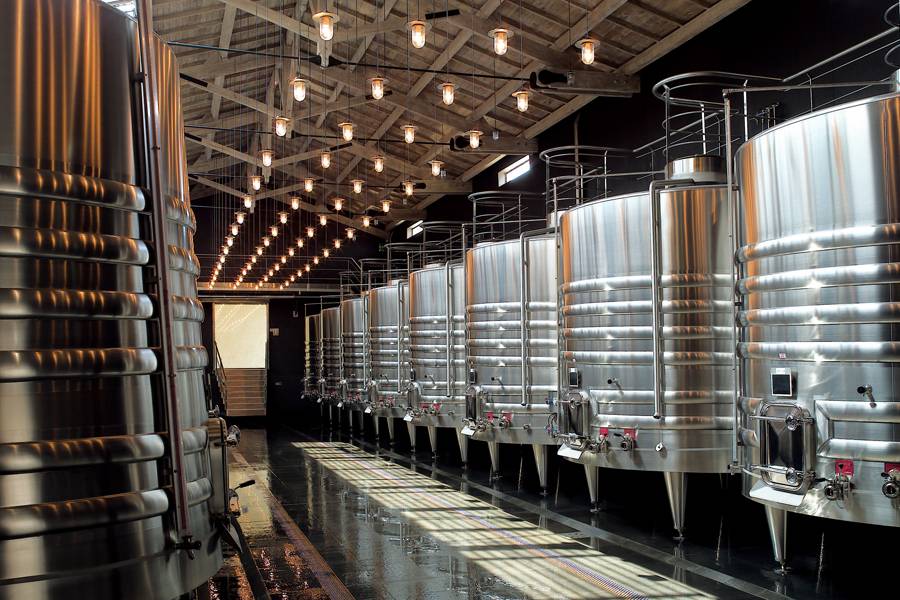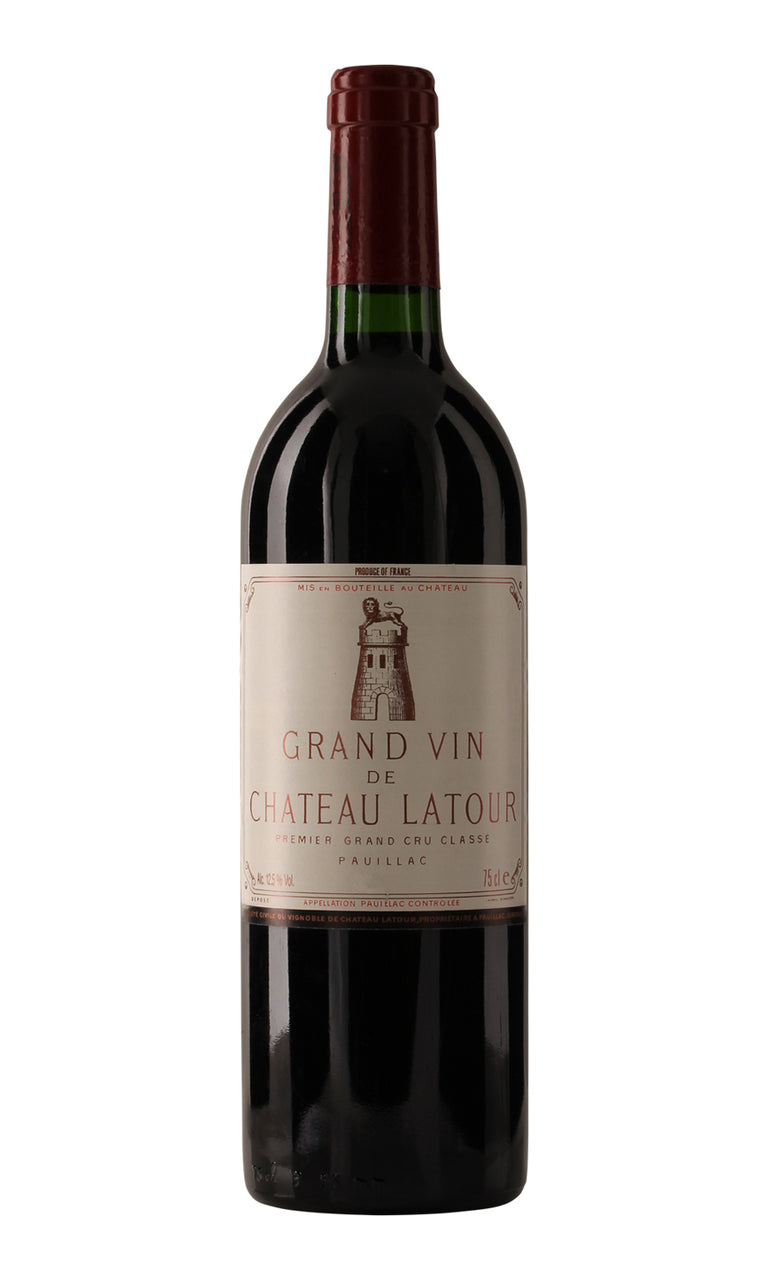- Colour Red
- Producer Château Latour
- Region Pauillac
- Drinking 2025 - 2060
- Case size 6x75cl
- Available Now
2010 - Ch Latour 1er Cru Pauillac - 6x75cl
- Colour Red
- Producer Château Latour
- Region Pauillac
- Drinking 2025 - 2060
- Case size 6x75cl
- Available Now
Select pricing type
Need help? Call +44 (0)20 7793 7900 or email wine@goedhuiswaddesdon.com.
-
Goedhuis, September 2022, Score: 98-99
Deep intense garnet colour. Enticing savoury aromatics, hints of fresh herbs, a touch of vanilla and spice. The weight and structure of the vintage come through with its natural deep Pauillac intensity. The tannins are perfectly pitched, sitting behind the noticeable volume of fruit. No doubting the breeding of this high class wine, this has huge dimension, robust, full and long with a very long life ahead of it. Drink 2025 – 2060.
-
Goedhuis, April 2011, Score: 96-99
A real showstopper and undoubtedly a great wine in the making. This is everything that Ch Latour should be with its huge brooding power and stunning volume of fruit. With over 90% of Cabernet Sauvignon in the blend this is an immense wine, rich, full and concentrated. For some, its weight and structure could be a little overburdening, but there are huge levels of complexity, and this is very much destined for the long term. A class act. DR
-
Neal Martin, February 2013, Score: 100
Tasted at the chateau, my sample was decanted for almost three hours. After the fireworks on the nose of the Les Forts de Latour, the Grand Vin comes as a shock. You have to readjust your mindset - this is subtle, understated, brooding Latour. Leaving it to one side to open up, it gradually unfurls to reveal very precise black fruits and minerals. It is not as immediate as say, Margaux or Lafite, but draws you in to its charms. The aromatics are misleading. The palate is incredibly intense with mouth-gripping tannins even although the IPT is actually less than the Les Forts de Latour. It offers unbelievably intensity, an almost brutal Latour at the moment that will need 15-20 years in bottle before it becomes approachable. This will rank alongside legends such as the 1961 and 1982 - but it is a wine for the next generation, not mine.
-
Neal Martin, March 2011, Score: 96-98+
A blend of 90.5% Cabernet Sauvignon, 8.5% Merlot, 0.5% Cabernet Franc and 0.5% Petit Verdot with 14.4% alcohol. The Grand Vin is quite conservative and "strict" at first, very pure with cedar and graphite dominating the profile against a backdrop of pure black fruit. But it opens up with 3-4 minutes of aeration with hints of gravel, perhaps crushed rose petals lending it a femininity to counter its intrinsic masculinity. The palate is full-bodied with firm tannins, real grip in the mouth, even more intensity than the 2009 but with that weightlessness and elegance towards the finish. Extraordinary. Drink 2020-
-
Robert Parker, April 2020, Score: 100
The 2010 Latour is deep garnet in color, and—WOW—it erupts from the glass with powerful crème de cassis, Black Forest cake and blackberry pie scents plus intense sparks of dried roses, cigar boxes, fragrant earth and smoked meats with aniseed and crushed rocks wafts. Full-bodied, concentrated and oh-so-decadent in the mouth, it has a firm, grainy texture and lovely freshness carrying the rich, opulent fruit to an epically long finish. It is incredibly tempting to drink now, but I suspect this hedonic experience isn't a scratch on the mind-blowing, otherworldly secrets this time capsule will have to reveal given another 7-10 years in bottle and continuing over the following fifty years++. 2024-2080 Lisa Perotti-Brown
-
Robert Parker, February 2013, Score: 100
One of the perfect wines of the vintage, Frederic Engerer challenged me when I tasted the 2010 Latour at the estate, asking, “If you rate the 2009 one hundred, then how can this not be higher?” Well, the scoring system stops at 100, (and has for 34 years,) and will continue for as long as I continue to write about wine. Nevertheless, this blend of 90.5% Cabernet Sauvignon, 9.5% Merlot, and .5% Petit Verdot hit 14.4% natural alcohol and represents a tiny 36% of their entire production. The pH is about 3.6, which is normal compared to the 3.8 pH of the 2009, that wine being slightly lower in alcohol, hence the combination that makes it more flamboyant and accessible. The 2010 is a liquid skyscraper in the mouth, building layers upon layers of extravagant, if not over-the-top richness with its hints of subtle charcoal, truffle, blackberry, cassis, espresso and notes of toast and graphite. Full-bodied, with wonderfully sweet tannin, it is a mind-boggling, prodigious achievement that should hit its prime in about 15 years, and last for 50 to 100. There is no denying the outrage and recriminations over the decision by the Pinault family and their administrator, Frederic Engerer, to pull Latour off the futures market next year. However, you can still buy these 2010s, although the first two wines are not likely to be released until they have more maturity, which makes sense from my perspective. Perhaps Latour may have offended a few loyal customers who were buying wines as futures, but they are trying to curtail all the interim speculation that occurs with great vintages of their wines (although only God knows what a great vintage of future Latour will bring at seven or eight years after the harvest). As a set of wines, the 2010s may be the Pinaults’ and Engerer’s greatest achievements to date. Of course, I suspect the other first-growth families won’t want to hear that, nor will most of the negociants in Bordeaux, but it’s just the way things are. Frederic Engerer, by no means the most modest of administrators at the first growths, thinks it would be virtually impossible to produce a wine better than this, and he may well be correct. If they gave out Academy Awards for great performances in wine, the Pinaults and Engerer would certainly fetch a few in 2010. P.S. Just so you don’t worry, Engerer offered up the 2009 next to the 2010 to see if I thought it was still a 100-point wine, and yes, ladies and gentlemen, it still is.Drink: 2028-2078
-
Robert Parker, May 2011, Score: 98-100
It's too early to know for sure, but the 2010 Latour appears to be a huge and massive Pauillacfruit bomb from this property. With 14.4% natural alcohol, this blend of 90.5% Cabernet Sauvignon, 8.5% Merlot and .5% Cabernet Franc, director Frederic Engerer told me it is unlike any other wine made at this estate. Possessing abundant amounts of everything, it even eclipses the 2009 in terms of power with a lower pH and higher total acidity. Representing only 36% of the production (making it even more difficult to find than usual, as this is the smallest of the Medoc first growths), it possesses an opaque black/purple color along with an extraordinary perfume of spring flowers, blueberry, blackberry and cassis liqueurs and hints of white chocolate as well as earth intermixed with vague charcoal and truffle-like components. With unreal concentration, full-bodied power, and a precision, freshness and refined level of tannins that are something to behold, this remarkable offering is one of my personal favorites of the vintage. It will undoubtedly shut down after bottling and enjoy 50-60 years of longevity.
-
James Suckling, April 2011, Score: 98-99
The quality of the tannins and density of fruit is truly beautiful. This is so focused, with purity and beauty. The 1990 Latour came into my head when I tasted this (twice). It starts off slowly and then builds and builds and builds . So intellectual. A superb wine with precision 90.5 percent Cabernet Sauvignon, 8.5 percent Merlot, .5 percent Cabernet Franc and .5 Petit Verdot.
-
Decanter, April 2011, Score: 20
Sensational depth of colour, incredible sweetness and ripeness of fruit, but very massive now, a monumental expression of the Latour vineyards. Drink 2025-70.
-
Jancis Robinson, April 2011, Score: 19
90.5% Cabernet Sauvignon, 8.5% Merlot, and a drop each of Cabernet Franc and Petit Verdot. 36% of total production. Extremely dark purple. Again, more ‘glamour' than I expected. Especially on thenose. Very ambitious and gorgeous. Thick and dense and hugely long term and dry on the end. Spices – something quite Asian about this – a hint of Szechuan pepper. Explosive. Super dry and introvert but with great velvety texture. So introvert and super dry, super Latour. Monumental. The massive fruit lurks underneath the very ripe tannins at the moment. IPT 83, less than Les Forts, but it tastes much firmer. 14.4%. Drink 2025-2055
-
Wine Spectator, March 2011, Score: 96-99
That character is on full display in the grand vin. Reticent at first, but with time and air in the glass, it becomes lush and layered, with nearly endless fig sauce, currant compote and blackberry cobbler notes, wound with cocoa, espresso and charcoal. It's seamless, despite itspower and range, with hints of violet, blood orange and spicebox flittering in as it airs in the glass. 90.5 percent Cabernet Sauvignon, 8.5 percent Merlot and one-half percent each of Cabernet Franc and Petit Verdot
Producer
Château Latour
It is a common misconception that Château Latour was named after its cream-coloured tower - a 17th century edifice that served as a dovecote. The original tower that gave its name to this exemplary property was built in the 15th century as a watchtower to fend off invading pirates during the Hundred Years War. Unfortunately, it has long been eroded away. Château Latour's vines are planted on the gravel soil of Paulliac, mos...Read more
It is a common misconception that Château Latour was named after its cream-coloured tower - a 17th century edifice that served as a dovecote. The original tower that gave its name to this exemplary property was built in the 15th century as a watchtower to fend off invading pirates during the Hundred Years War. Unfortunately, it has long been eroded away. Château Latour's vines are planted on the gravel soil of Paulliac, most of them stand 12 to 16 metres above the Gironde Estuary. It can be considered the King of the First Growths, having the extraordinary power, structure and presence.Read less

Region
Pauillac
Due south of St Estèphe lies the appellation of Pauillac, the king of Left Bank communes. It is home to three first growths as well as a plethora of other classified growths. Pauillac's renowned well-draining, gravelly soils enable its dominant grape Cabernet Sauvignon to reach fantastic heights of complexity and concentration. As a result, Pauilac's wines tend to be full-bodied with compact tannins and good freshness. Its aromatics are often what one associates with classic Bordeaux: pencil shavings, black currant and occasional mint. Some of the most famous châteaux of the commune are Latour, Mouton Rothschild, Lafite Rothschild, Pichon Baron, Pichon Lalande and Lynch Bages.




